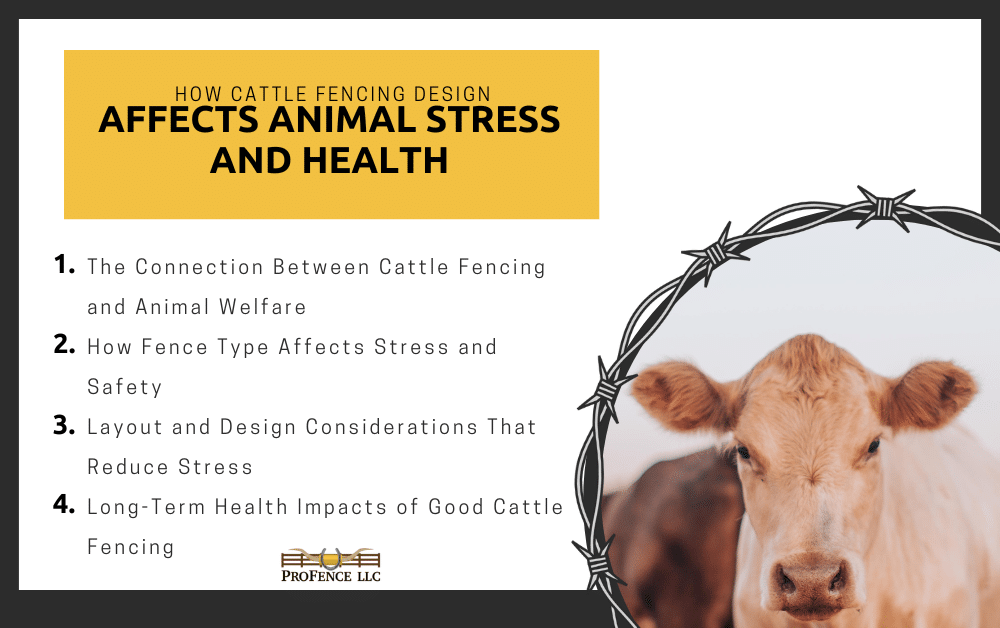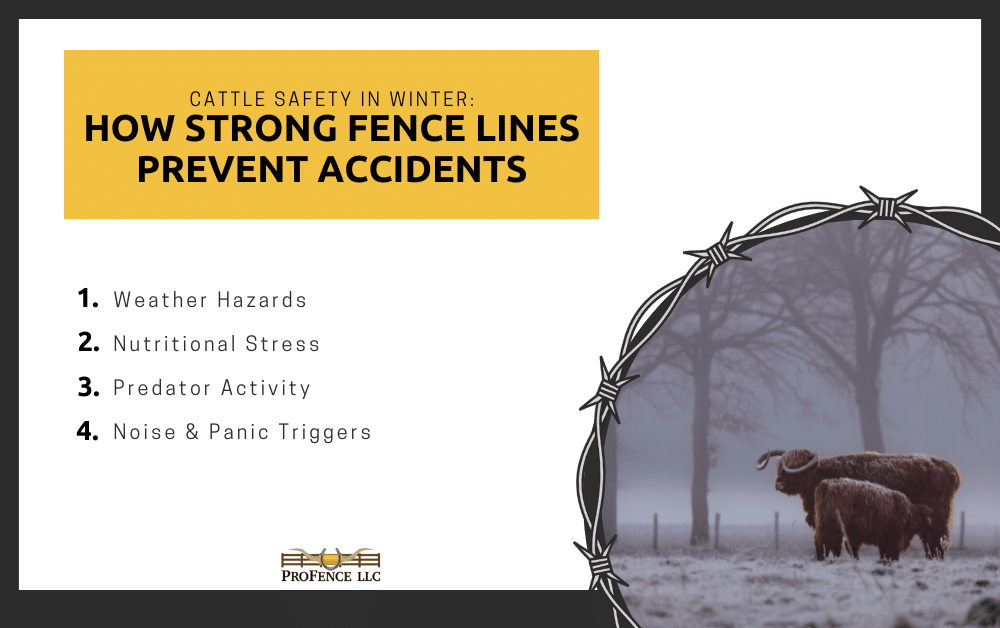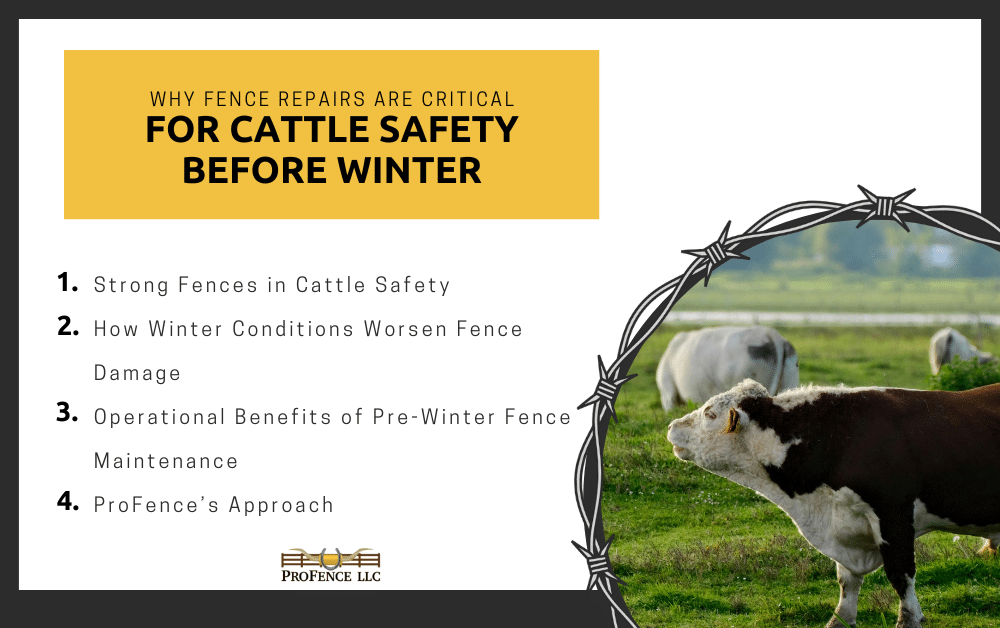When it comes to raising cattle, a good fence isn’t just about keeping animals in—it’s about keeping them safe, healthy, and low-stress. Whether you’re managing a large herd or just a few head, the way your cattle fencing is designed can have a big impact on your animals’ well-being. Poorly planned fencing can lead to injuries, stress, and even lost productivity. On the other hand, well-built cattle fencing supports healthy grazing habits, reduces pressure on the herd, and protects your investment.
At ProFence, we’ve installed all types of cattle fencing—from high-tensile and electric to woven wire and board fencing—across hundreds of farms. In this post, we’ll break down how the right fence design helps improve your cattle’s stress levels and overall health.
The Connection Between Cattle Fencing and Animal Welfare
Understanding Stress in Cattle
Cattle are naturally alert animals, always watching for danger. When they’re unsure of their surroundings—or feel trapped—they can become stressed. Stress in cattle affects weight gain, milk production, and even how often they get sick. That’s why proper cattle fencing is more than a barrier—it’s a tool for creating a calm and safe environment.
How Poor Fencing Creates Problems
When fencing is too low, hard to see, or not properly maintained, cattle may push, rub, or try to escape. This leads to injuries, damaged fencing, and frustrated farmers. Barbed wire or loose boards can cause cuts and infections. Strong, well-installed cattle fencing, like what ProFence builds, helps avoid these issues before they start.
The Role of Fence Design in Animal Behavior
Good fence design guides cattle movement without force. For example, using ProFence’s high-tensile wire allows for wide, clear boundaries that cattle can see and respect. Electric fencing gives a quick reminder without harm, training cattle to stay within their pasture. A calm, clear setup keeps cattle from feeling trapped or anxious.
Benefits to Herd Health and Performance
Reduced stress means fewer vet visits and better gains. Calmer animals spend more time grazing and lying down—both essential for weight and milk production. When your cattle fencing supports natural behavior, your whole operation runs smoother and more efficiently.
Why Farmers Should Care
Farmers already work hard to keep their herd healthy, and fencing can either help or hurt those efforts. With ProFence, the focus is on building long-lasting, low-stress cattle fencing that protects your animals and your bottom line. A little thought into fence design today pays off in herd health tomorrow.
How Fence Type Affects Stress and Safety
High-Tensile Wire: Strength Without Harm
ProFence installs a lot of high-tensile cattle fencing, and for good reason—it’s strong, flexible, and low-maintenance. This type of fencing keeps cattle in without needing barbs that can injure them. When tensioned correctly, it can withstand pressure from the herd without breaking or causing harm. High-tensile fences also offer a clean, wide boundary that cattle can recognize easily. This helps reduce the stress that comes from unclear or unsafe fencing.
Electric Fencing: A Gentle Reminder
Electric cattle fencing works more as a psychological barrier than a physical one. A mild, quick shock teaches cattle to stay within the fence line without causing pain or injury. ProFence often combines electric fencing with high-tensile wire for added control. This method discourages leaning or rubbing, keeping cattle safer and fences intact. When cattle learn to respect electric fencing, they become easier to manage and less likely to test their boundaries.
Woven Wire: Ideal for Calves and Mixed Herds
Woven wire fencing provides a solid physical barrier, especially helpful when managing calves or different livestock together. The mesh pattern prevents animals from slipping through or getting stuck. While not as flexible as high-tensile or electric setups, woven wire is still a great option for tighter areas like barnyards or smaller paddocks. ProFence recommends pairing woven wire with a strand of electric wire on top to stop climbing or leaning.
Barbed Wire: Traditional but Risky
Many farmers still use barbed wire for cattle fencing, but it comes with downsides. While it’s effective at containment, it also increases the risk of cuts, infections, and stress from entanglement. Barbed wire can cause long-term damage, especially in younger or more active cattle. ProFence generally recommends safer alternatives, unless barbed wire is absolutely necessary for large, remote areas.
Board Fencing: Durable and Highly Visible
Post-and-board cattle fencing offers strength and visibility, making it ideal for high-traffic areas like driveways, gates, or handling zones. Cattle see the boards clearly, which helps reduce panic or charging. While board fencing costs more and needs upkeep, ProFence clients often use it for corrals or lanes where safety and control matter most. Its solid structure keeps animals calm during loading or vet visits.
Layout and Design Considerations That Reduce Stress
Visibility Prevents Panic
Cattle need to clearly see their boundaries to feel secure. When fencing is hard to see—like thin wire without markers—it can cause confusion or panic. Using visible materials such as board fencing or flagged wire helps cattle understand where not to go. Research on virtual fencing welfare shows that clear visual cues reduce stress and improve learning. Well-marked cattle fencing helps keep animals calmer and more confident in their space.
Avoid Sharp Angles and Tight Corridors
Fence lines that create sharp corners or tight spaces can cause problems, especially during herding. Cattle naturally avoid areas where they feel trapped, and poor layout can lead to hesitation, injury, or chaos. Designing pastures with wide turns and smooth flow helps cattle move freely and calmly. This is especially important near gates, feeding areas, or when rotating pastures.
Space Matters in Reducing Herd Pressure
Overcrowded pastures lead to pushing, competition, and higher stress levels. Proper cattle fencing allows you to divide grazing areas, giving cattle room to spread out. Controlled rotation and space management improve both animal welfare and land health. Giving cattle enough room to graze, rest, and move without crowding supports overall herd calmness.
Access to Resources Without Conflict
Stress often builds around limited access to water, feed, or shade. When too many animals crowd a single resource, it can cause fights or injuries. Fence design should ensure there are multiple access points and avoid bottlenecks. This reduces aggression and lets cattle eat and drink without pressure.
Easy Movement Between Zones
Cattle do best when they can move naturally from one area to another. Gates and lanes should be wide and well-placed to encourage smooth transitions. Whether you’re rotating pastures or moving cattle for health checks, thoughtful cattle fencing design makes the process easier and less stressful for everyone.
Long-Term Health Impacts of Good Cattle Fencing
Fewer Injuries Mean Healthier Herds
Poorly designed fencing—such as loose wires, sharp barbs, or broken boards—can cause serious injuries. Cuts and scrapes from damaged fence lines may go unnoticed until they develop into infections or lameness. Choosing safer cattle fencing materials—like smooth high-tensile wire or sturdy board fencing—helps prevent those issues, ensuring your herd stays healthier and more productive.
Reduced Stress Supports Better Gains
Stress lowers appetite and energy in cattle, which negatively impacts weight gain and milk production. Thoughtful cattle fencing design provides animals with clear, open space to graze and rest without frequent disturbances. Calmer animals eat better, lie down more, and grow faster—supporting smoother operation and stronger herd performance.
Better Behavior, Easier Handling
Well-built, visible fence lines help cattle remain calm during handling and movement. When cattle can see their path and don’t feel trapped, they’re less likely to balk or bolt. That results in easier transitions during pasture rotation, loading, or veterinary care—keeping both animals and handlers safer.
Healthier Grazing Through Pasture Control
Good cattle fencing facilitates rotational grazing by dividing pasture into manageable paddocks. This helps avoid overgrazing, reduces mud and parasite buildup, and promotes forage recovery. Better-quality grass supports healthier cattle nutrition, immune strength, and long-term resilience.
Lower Vet Bills and Long-Term Savings
While high-quality fencing may require a larger initial investment, it pays dividends over time. Fewer animal injuries mean fewer vet visits, and healthier cattle boost profitability. Smart, low-stress cattle fencing ultimately helps protect your herd’s well-being—and your farm’s bottom line.
Conclusion: Design with Their Well‑Being in Mind
Cattle fencing isn’t just about keeping animals inside a boundary—it’s about creating a safe, low-stress environment that supports healthy, productive livestock. When fencing is designed with cattle behavior in mind, everything from movement to grazing becomes smoother. That means fewer injuries, better weight gain, and calmer handling.
Whether you’re building new paddocks, updating old fencing, or planning a rotational grazing system, the design choices you make now will impact your herd’s long-term health. Materials matter, layout matters, and visibility matters. It’s not about overbuilding—it’s about building smart.
If you’re evaluating your current setup, it may be time to consider adjustments that better support your animals and your operation. Investing in quality cattle fencing pays off in stronger herds and lower costs over time.







